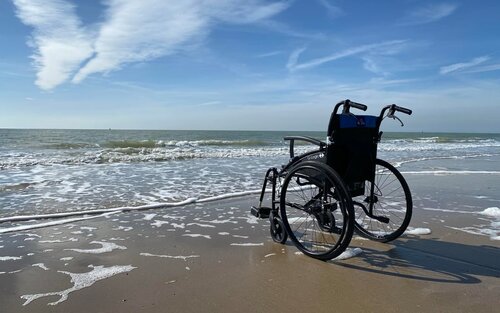The hallmark of flaccid paralysis is that the transmission of impulses through the nerves is absent, because the motor neurons between the spine and muscles are damaged. This is how flaccid paralysis is generally distinguished from spastic paralysis, in which the tension of the muscles (the muscle tone) in constantly increased due to damage in the brain or the spine.
Because of the absence of signal transmissions and the lack of use of the muscle, atrophy occurs and over time the muscle mass deteriorates greatly, being partly replaced by fat and connective tissue.
Causes
The reasons for flaccid paralysis are diverse. They can be divided into toxic-inflammatory causes and mechanic-traumatic causes. In both cases, the signal transmission from the spine to the muscle is disrupted by inflammation around the nerves or the spine. Tumours, toxins, or autoimmune diseases can be the underlying cause here. Flaccid paralysis may also occur after accidents where, for example, nerves get pinched or severed.
Treatment
The treatment options for flaccid paralysis are oriented around the extent and cause of the condition. If there is innervation or paralysis due to a toxin or inflammation, it is important to treat this primary issue. In this case medication may be introduced to combat the inflammation, for example. If tumours are behind the damage to the motor neurons, then extensive measures might be necessary to eradicate the swelling. Radiation, chemotherapy, or surgical removal might be considered here, among other things.
In the case of pinched or damaged nerves surgical procedures are considered under certain circumstances to improve capabilities. If the nerve is completely severed, however, this cannot be repaired via operation.
Regular physiotherapy can contribute to the maintenance of the retained mobility and delay the deterioration of the muscles. It must be decided on an individual basis by the treating physician which treatment options make most sense and how the respective exercises and medical measures can be combined.
Disability
Flaccid paralysis can lead to lasting impairments in individuals. This is particularly the case when they persist for a period longer than six months with no expectation of significant improvements. In this case an application for a recognised disability can be made at the pension office or with the relevant local authorities. It is advisable here to have a consultation with your treating doctor, as they must verify your health state in a specialist medical report. If a disability is ascertained, the affected person receives a disability pass and has the right to the benefits connected with it, which often means some kind of financial relief.

